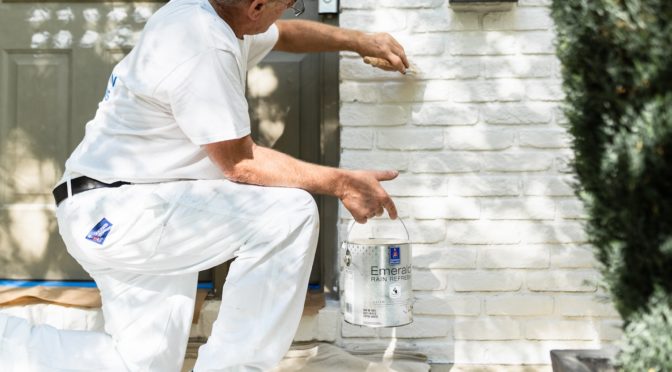Brick inherently needs no paint. But your customer may have several reasons to do so, ranging from cosmetic color changes to improving the look of a damaged substrate. Sherwin-Williams Product Manager Frank Flores answers some of the most common questions contractors have about painting brick.
First, are there any general guidelines for painting brick?
The condition of the brick has a lot to do with how you want to proceed. Old, worn out-looking brick could still be in sound shape and may just need repointing and the application of a clear water repellant.
Pitted or spalled brick may be a great candidate for a flat paint that will not highlight every imperfection.
In general, brick in disrepair should not be painted. Aged, non-glazed brick can be coated successfully with the proper prep and coatings. But exterior glazed brick should not be painted, unless the glaze is first removed.
Exterior brick should be weathered at least one year prior to painting. (Most interior brick does not weather.)
What kind of surface prep do you recommend?
The brick must be clean, dry, dull and in sound condition. Loose peeling paint must be removed. Mortar should be in sound condition and repaired (repointing), if needed.
Recognize that any surface preparation short of total removal of the old coating may compromise the service length of the new system. We recommend removing all surface contamination by washing with a good cleaner degreaser or other neutral pH cleaners. Rinse thoroughly and allow the surface to dry.
Then, test the absorbency of the brick by sprinkling water on the surface.
If the water penetrates into the brick quickly, the brick is ready to finish. If the water beads up or does not penetrate, that is an indication that there is some type of treatment on the brick that should be allowed to weather away.
If the brick is ready to paint, prime the brick with a quality acrylic latex masonry conditioner. Masonry conditioner is a pigmented sealer and surface conditioner recommended for use on exterior masonry such as brick, block, and weathered or bare stucco. Allow the primer to dry for 24 hours. Then follow with two coats of a quality exterior concrete and masonry acrylic coating.
Can I use a primer instead of a masonry conditioner?
We recommend priming with Loxon® Acrylic Conditioner or an alkali-resistant primer, such as Loxon® Concrete and Masonry Primer. Either one can be used, based on the job requirements.
Loxon Concrete and Masonry Primer is applied anywhere from 5 to 8 mils wet and dries to 2 to 3 mils per coat. The volume solids are about 40 percent so when applied it will have the appearance of a solid primer film. I would use this primer on older pitted or spalled brick that is in bad shape and needs a good primer and flat paint to hide imperfections.
Loxon® Acrylic Conditioner is available in Clear or Guide Coat White. With volume solids at 16 to 18 percent, these are not full-bodied primers. They’re meant to be applied very thin to penetrate the surface and not build a surface glaze. Loxon Conditioner also helps bond light chalk on the surface.
We would use this product on a surface at least one year or older, in good sound shape, followed by an alkali resistant finish like Loxon® Self-Cleaning Acrylic Coating or other Loxon finishes.
What about my options for the topcoat?
Loxon Self-Cleaning Acrylic Coating is engineered to keep exterior above-grade masonry looking fresh, clean and attractive with a self-cleaning formula that sheds dirt with rainwater or water contact. With advanced durability, water-shedding, wind driven rain and dirt pick-up resistance, this high-performance coating helps avoid costly repaints and extensive cleaning–without sacrificing aesthetics.
Is there an advantage to using a sealer, or a paint with sealer in it? How does this protect the brick?
A clear sealer and paint films can help shed water and keep it from penetrating the brick. Water behind the brick wall can damage not only the brick but the wall cavity itself. So it’s important to keep the water out so it does not collect or freeze. Water that freezes behind or in the brick may cause the brick to spall, or peel or pop off the face of the brick.
Will I need special types of brushes, painter’s tape, cleaners or other equipment?
This would vary based on the paint used as well as the condition of the brick. With latex masonry coatings, we recommend using a nylon/polyester brush like the Purdy® Pro-Extra.
For rolling, use a synthetic nap ranging from 1⁄2 inch to 1 inch, depending on the condition and porosity of the brick. Purdy® Marathon Roller Covers are a good choice.
A good cleaner degreaser or other neutral pH cleaner will help remove surface contamination. Standard painters tape works fine on brick.
This article was published in the Spring 2024 issue of Pintor Pro. ©2024 Fusable. Read more stories about coatings products and application techniques in the Pintor Pro magazine archive.




